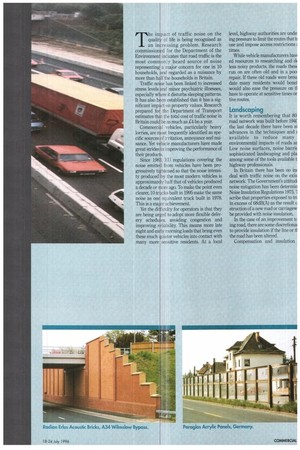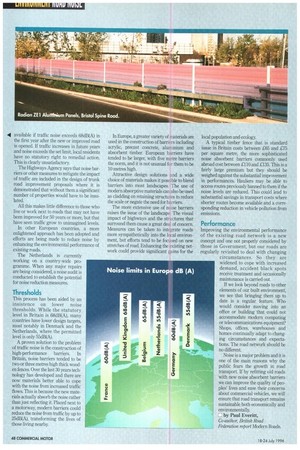e inipact of traffic noise on the r r i
Page 49

Page 50

If you've noticed an error in this article please click here to report it so we can fix it.
quali of life is being recognised as an in reasing problem. Research commissio d for the Department of the Environmen4 indicates that road traffic is the most comr4only heard source of noise representing a major concern for one in 10 households, nd regarded as a nuisance by more than hf1f the households in Britain.
Traffic noise has been linked to increased stress levels ;ind minor psychiatric illnesses, especially where it disturbs sleeping patterns. It has also been established that it has a significant impact on property values. Research prepared for th,?. Department of Transport estimates that the total cost of traffic noise in Britain could be as much as £4 bn a year.
Commercial vehicles, particularly heavy lorries, are most frequently identified as specific sources bf irritation, annoyance and nuisance. Yet vehicle manufacturers have made great strides in improving the performance of their products.
Since 198 , EU regulations covering the
noise emi from vehicles have been progressively ti htened so that the noise intensity produced by the most modern vehicles is approximat y half that of vehicles produced a decade or re ago. To make the point even clearer, 10 tr cks built in 1995 make the same noise as o equivalent truck built in 1978. This is a ma r achievement.
Yet the di culty for operators is that they are being ur ed to adopt more flexible delivery sched es, avoiding congestion and improving liability. This means more late night and ea ly morning loads that bring even these much uieter vehicles into contact with many more sensitive residents. At a local level, highway authorities are undE ing pressure to limit the routes that b use and impose access restrictions times.
While vehicle manufacturers havi ed resources to researching and d less noisy products, the roads then run on are often old and in a pool repair. If these old roads were brot date many resident; would bene would also ease the pressure on t have to operate at sensitive times oi tive routes.
Landscaping
It is worth remembering that 80 road network was built before 1941 the last decade there have been s advances in the techniques and available to reduce many environmental impacts of roads ai Low noise surfaces, noise barrii sophisticated landscaping and ph among some of the tools available 1 highway professionals.
In Britain there has been no deal with traffic noise on the exis network. The Government's attitud noise mitigation has been determir Noise Insulation Regulations 1975." scribe that properties exposed to In in excess of 68dB(A) as the result t struction of a new road or cariiagew be provided with noise insulation.
In the case of an improvement ti jag road, there are some discretiona to provide insulation if the line or ti the road has been altered.
Compensation and insulation
41 available if traffic noise exceeds 68dI3(A) in the first year after the new or improved road is opened. If traffic increases in future years and noise exceeds the set limit, local residents have no statutory right to remedial action. This is clearly unsatisfactory.
The Highways Agency says that noise barriers or other measures to mitigate the impact of traffic are included in the design of trunk road improvement proposals where it is demonstrated that without them a significant number of properties would have to be insulated.
All this makes little difference to those who live or work next to roads that may not have been improved for 50 years or more, but that have seen traffic grow to unimagined levels.
In other European countries, a more enlightened approach has been adopted and efforts are being made to reduce noise by enhancing the environmental performance of existing roads.
The Netherlands is currently working on a country-wide programme. When any major repairs are being considered, a noise audit is conducted to establish the potential for noise reduction measures.
Thresholds
This process has been aided by an insistence on lower noise thresholds, While the statutory level in Britain is 68dB(A), many countries have lower design targets, most notably in Denmark and the Netherlands, where the permitted level is only 55dB(A).
A proven solution to the problem of traffic noise is the construction of high-performance barriers. In Britain, noise barriers tended to be two or three metres high thick wooden fences. Over the last 30 years technology has developed and there are now materials better able to cope with the noise from increased traffic flows. This is because the new materials actually absorb the noise rather than just reflecting it. Placed next to a motorway, modern barriers could reduce the noise from traffic by up to 25dB(A), transforming the lives of those living nearby. In Europe, a greater variety of materials are used in the construction of barriers including acrylic, precast concrete, aluminium and absorbent timber. European barriers have tended to be larger, with five metre barriers the norm, and it is not unusual for them to be 10 metres high.
Attractive design solutions and a wide choice of materials makes it possible to blend barriers into most landscapes. The use of modern absorptive materials can also be used as cladding on retaining structures to reduce the scale or negate the need for barriers.
The more extensive use of noise barriers raises the issue of the landscape. The visual impact of highways and the structures that surround them cause a great deal of concern. Measures can be taken to integrate roads more sympathetically into the local environment, but efforts tend to be focused on new stretches of road. Enhancing the existing network could provide significant gains for the local population and ecology.
A typical timber fence that is standard issue in Britain costs between £65 and .£75 per square metre, the more sophisticated noise absorbent barriers commonly used abroad cost between £110 and £135. This is a fairly large premium but they should be weighed against the substantial improvement in performances. Hauliers may be able to access routes previously banned to them if the noise levels are reduced. This could lead to substantial savings in transport costs where shorter routes become available and a corresponding reduction in vehicle pollution from emissions.
Performance
Improving the environmental performance of the existing road network is a new concept and one not properly considered by those in Government, but our roads are regularly revisited to deal with changing circumstances. So they are widened to cope with increased demand, accident black spots receive treatment and occasionally maintenance is carried out.
If we look beyond roads to other elements of our built environment, we see that bringing them up to date is a regular feature. Who would consider moving into an office or building that could not accommodate modern computing or telecommunications equipment? Shops, offices, warehouses and homes continually adapt to changing circumstances and expectations. The road network should be no different.
Noise is a major problem and it is one of the main reasons why the public fears the growth in road transport. If by refitting old roads with new noise absorbent barriers we can improve the quality of peoples' lives and ease their concerns about commercial vehicles, we will ensure that road transport remains sustainable both economically and environmentally.
1by Paul Everitt,
Co-author, British Road Federation report Modern Roads.












































































































